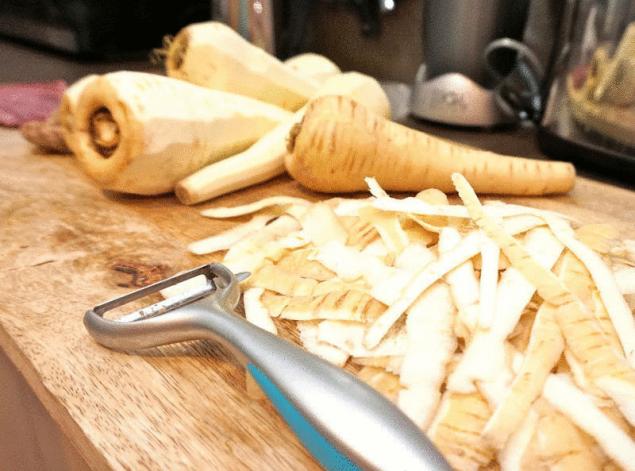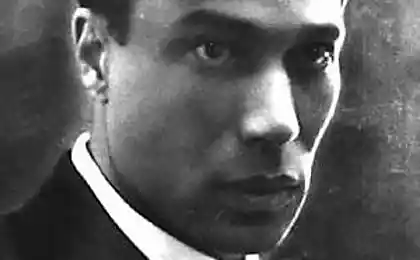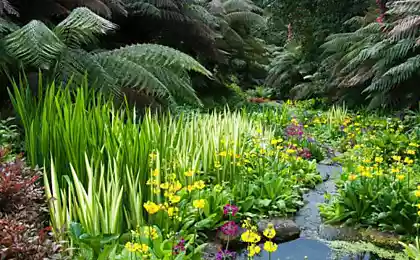487
Parsnip is the root of longevity
If you grow parsnips? Only a small number of gardeners-gardeners in the affirmative to this question. Which is a pity. After all, Pasternak called the "root of longevity".

In the East it is very common to magicians and soothsayers, healers and psychics. It was thought that who uses parsnip in its raw form — see prophetic dreams, the man added of mind, kindness of heart and peace of mind.
But many gardeners who regularly consume parsnips, they write what they owe their longevity. Homeland Pasternak considered the Europe and Central Asia. In former times, the European peoples Pasternak enjoyed enormous popularity — he was considered one of the major vegetable crops in donatiello era, but was subsequently strongly challenged by radishes, carrots and root parsley. Nowadays, it again is widely cultivated everywhere in Europe and only in our country has not yet gained popularity.
What is valuable parsnips?
This spicy plant resembles the smell of celery and parsley, is used in home cooking, for canning and pickling vegetables, and seasoning to the first and second dishes. It looks like a big root of parsley, but its nutritional and medicinal properties useful to her. This plant contains a large number of valuable organic compounds, is dry matter, ascorbic acid, vitamins B1 and B2, essential oils, furocoumarins. It is interesting that abroad on farms are grown parsnips for cattle feeding: eating roots, cattle are recovering, grows healthy, well-fed, milk is obtained with high fat.
Parsnip root is extremely nutritious and useful — the content of easily digestible Sugars — fructose, sucrose, glucose, it is three times higher than carrots, the level of vitamins, mineral salts and essential oils can compete with the best varieties of parsley. Because of that, and appreciate the parsnip is that it combines many useful properties of carrot, parsley, celery, with which it competes.
Characteristics of growing "root of longevity"
Parsnip — a biennial plant, in the first year, forming roots and a lush rosette of leaves, second flowers and seeds. Pasternak flesh is juicy, snow-white, fruit skin is yellowish wax, the shape of the root is conical or round. The leaves are large, long, to 30 cm long, petioles, rugged, with large portions. For the second year parsnips throws out a powerful, up to five feet, the stem, the end of which appear yellow-green flowers, then large seeds.
You need to know!
Forewarned inexperienced gardeners: green socket Pasternak highlights, especially in the morning and evening dew, quite pungent essential oils, and people with sensitive, prone to allergic skin rashes may even get burned.
Therefore, in dew and rain it is better to avoid unnecessary contact with the plant.
Frost is not afraid to soil picky
Parsnips cold-resistant, cold-resistant, can spend the winter outdoors without much consequences (such as carrots and parsley). It is water-loving, but well-tolerate drought. However, this does not mean that it does not need regular watering. On the contrary, the more abundant watering, the more powerful the root forms a parsnip.
It grows well on almost any soil enough that it was like should be dug and loosened.
When, how and where to sow parsnips
Sow it in the garden, which last year was fertilized with manure. Pasternak undemanding to predecessors, but feels better on the plots, where it grew cucumbers, zucchini, squash, onions, tomatoes, potatoes, cabbage. The area should be well lit — in the shadow of parsnips is better not to sow.
Ridge it's better to prepare in the fall. The soil is dug up and to make 1 m2 0.5 — 1 l of a bucket of compost, 3 tablespoons nitrophoska, 0.5 liters of ash or .1 tablespoon of potassium chloride. In early spring, the flower bed dug over again, when you do this, bring 1 tablespoon of urea per 1 m2.
Parsnips are sown in open ground in early spring as soon as the snow melts, at the same time as the carrots, parsley, radishes. Parsnips cold-resistant, it grows at +2...+ 3° C, and its seedlings can withstand freezing to -5° C, but Mature plants and up to -8...-7° C. the Best temperature for the growth and development of Pasternak's 15 — 20° C. it is Possible to sow parsnip before winter, in November, under "crock", as they say the old gardeners, i.e. when the top layer of the soil is already frozen by the frost, and formed a crust. It was under this crust sow parsnips, then the seeds well germinate in the spring. In General, the optimum time for planting parsnip in the spring of -20 — 25 APR.
What grade to put
Blooming in the second year parsnips — an excellent honey plant and attracts a variety of pollinators-insects in the garden.
The most common varieties:
Clean parsnips in late autumn, after all the root vegetables. While digging Pasternak is recommended to use gloves or tight gloves, to inflamed skin. However, already the day after harvesting parsnips is absolutely harmless. Clean parsnips, like turnips: break a shovel or pitchfork and pulled, trying not to damage the root. Then cut the tops level head.
Store root crops of parsnip at a temperature of +3° C, with potatoes. It can be a part of roots to dig up, they will spend the winter in the soil, just fill them up with leaves and snow. In this case, you will receive the spring very early and very fresh root vegetables — they can be digging by the end of March, as soon as you start to thaw the soil.
Parsnips in folk medicine
It is used for recuperation of recovering, as a diuretic and pain reliever, as an effective cure for kidney and stomach cramps: 2 tbsp fresh root mixed with 3 tablespoons of sugar, boil for 15 minutes in a glass of water in a closed enamelware and insist 8 hours. Take 1 tbsp. spoon 4 times a day 30 minutes before meals. Acute attacks of renal colic have used the juice of the fresh root parsnip, diluted 1:1 with water.
Decoction of roots: 2 tbsp. chopped roots pour 1 Cup of boiling water and boil for 30 minutes, cool, strain, take 1 tbsp. spoon 4 times a day for pain in heart, stomach, kidneys, nervous stress 1/4 Cup.
Infusion of leaves: 1-1,5 tablespoon of crushed leaves pour a glass of boiling water, cool and take 1 tbsp.spoon 3 times a day.

Parsnip can be cooked...
As for the food, what a parsnip is,
None of the roots are not the best food.
Odo of MENA. "On herbs"
Food in Pasternak's works are mainly root crops. Parsnip root has a sweet flavor reminiscent of carrots, and a strong spicy aroma, it is close to the parsley and celery. The root is used to make soups, with stews, it is added to summer salads and harvesting for the winter, finally, the root is simply dried and added to various dishes. Needless to say that leaves Pasternak — great greens, good salads, soups and stew, as a green condiment for grilled meat, as a great spice for blanks and just in dried form. From the dried roots of parsnip cook delicious and healthy tonic drink (chicory).
Salad parsnip
To prepare the salad of parsnip you need to boil 2 — 3 litres of water together with spices and vinegar, season with salt, if desired, add sugar. Parsnips cut, scalded with boiling water and boil for two minutes, then drain the water and cook until soft. Transfer to a bowl, pour vegetable oil and decorate with raw, chopped onion.
Preparation for sauce parsnip
Parsnips boil, pass through a meat grinder and to wipe through frequent sieve, then put in a saucepan, add the vinegar, tomatoes, add crushed Bay leaves, cloves, vegetable oil and boil for about half an hour. Then pass through a sieve, pour into bottles and seal. To prepare the workpiece for the sauce does: Pasternak — 1 kg, tomato — 400 g vegetable oil — 100 g, vinegar — 200 g salt — 30 g, Bay leaf and cloves for 1 g. to make the sauce, you need to take a piss from the bottle 100 g prepared weight, add 200 g of vegetable oil, dilute it all in 0.7 l of broth, add 100 g of sour cream, let boil the sauce is ready.
Parsnip stew
The roots of parsnip to prepare, finely chop and saute in oil. Sprinkle crushed or ground crackers, to put three minutes in the oven. Instead of crackers you can sprinkle with grated cheese.published
P. S. And remember, only by changing their consumption — together we change the world! ©
Source: slawa.su/zdrava/flora/1674-pasternak.html

In the East it is very common to magicians and soothsayers, healers and psychics. It was thought that who uses parsnip in its raw form — see prophetic dreams, the man added of mind, kindness of heart and peace of mind.
But many gardeners who regularly consume parsnips, they write what they owe their longevity. Homeland Pasternak considered the Europe and Central Asia. In former times, the European peoples Pasternak enjoyed enormous popularity — he was considered one of the major vegetable crops in donatiello era, but was subsequently strongly challenged by radishes, carrots and root parsley. Nowadays, it again is widely cultivated everywhere in Europe and only in our country has not yet gained popularity.
What is valuable parsnips?
This spicy plant resembles the smell of celery and parsley, is used in home cooking, for canning and pickling vegetables, and seasoning to the first and second dishes. It looks like a big root of parsley, but its nutritional and medicinal properties useful to her. This plant contains a large number of valuable organic compounds, is dry matter, ascorbic acid, vitamins B1 and B2, essential oils, furocoumarins. It is interesting that abroad on farms are grown parsnips for cattle feeding: eating roots, cattle are recovering, grows healthy, well-fed, milk is obtained with high fat.
Parsnip root is extremely nutritious and useful — the content of easily digestible Sugars — fructose, sucrose, glucose, it is three times higher than carrots, the level of vitamins, mineral salts and essential oils can compete with the best varieties of parsley. Because of that, and appreciate the parsnip is that it combines many useful properties of carrot, parsley, celery, with which it competes.
Characteristics of growing "root of longevity"
Parsnip — a biennial plant, in the first year, forming roots and a lush rosette of leaves, second flowers and seeds. Pasternak flesh is juicy, snow-white, fruit skin is yellowish wax, the shape of the root is conical or round. The leaves are large, long, to 30 cm long, petioles, rugged, with large portions. For the second year parsnips throws out a powerful, up to five feet, the stem, the end of which appear yellow-green flowers, then large seeds.
You need to know!
Forewarned inexperienced gardeners: green socket Pasternak highlights, especially in the morning and evening dew, quite pungent essential oils, and people with sensitive, prone to allergic skin rashes may even get burned.
Therefore, in dew and rain it is better to avoid unnecessary contact with the plant.
Frost is not afraid to soil picky
Parsnips cold-resistant, cold-resistant, can spend the winter outdoors without much consequences (such as carrots and parsley). It is water-loving, but well-tolerate drought. However, this does not mean that it does not need regular watering. On the contrary, the more abundant watering, the more powerful the root forms a parsnip.
It grows well on almost any soil enough that it was like should be dug and loosened.
When, how and where to sow parsnips
Sow it in the garden, which last year was fertilized with manure. Pasternak undemanding to predecessors, but feels better on the plots, where it grew cucumbers, zucchini, squash, onions, tomatoes, potatoes, cabbage. The area should be well lit — in the shadow of parsnips is better not to sow.
Ridge it's better to prepare in the fall. The soil is dug up and to make 1 m2 0.5 — 1 l of a bucket of compost, 3 tablespoons nitrophoska, 0.5 liters of ash or .1 tablespoon of potassium chloride. In early spring, the flower bed dug over again, when you do this, bring 1 tablespoon of urea per 1 m2.
Parsnips are sown in open ground in early spring as soon as the snow melts, at the same time as the carrots, parsley, radishes. Parsnips cold-resistant, it grows at +2...+ 3° C, and its seedlings can withstand freezing to -5° C, but Mature plants and up to -8...-7° C. the Best temperature for the growth and development of Pasternak's 15 — 20° C. it is Possible to sow parsnip before winter, in November, under "crock", as they say the old gardeners, i.e. when the top layer of the soil is already frozen by the frost, and formed a crust. It was under this crust sow parsnips, then the seeds well germinate in the spring. In General, the optimum time for planting parsnip in the spring of -20 — 25 APR.
What grade to put
Blooming in the second year parsnips — an excellent honey plant and attracts a variety of pollinators-insects in the garden.
The most common varieties:
- The early round. Root length up to 12 and a diameter up to 10 cm, early maturing, growing period of 100 days. Suitable for soils with a small plough layer.
- Best of all — medium early, vegetation period 110 — 115 days, root length of 15 — 20 cm.
- Student. Late-ripening, growing season is 140 — 150 days, the root length of 25 — 35 cm.
- Garneski — late-maturing, high-yielding.
Clean parsnips in late autumn, after all the root vegetables. While digging Pasternak is recommended to use gloves or tight gloves, to inflamed skin. However, already the day after harvesting parsnips is absolutely harmless. Clean parsnips, like turnips: break a shovel or pitchfork and pulled, trying not to damage the root. Then cut the tops level head.
Store root crops of parsnip at a temperature of +3° C, with potatoes. It can be a part of roots to dig up, they will spend the winter in the soil, just fill them up with leaves and snow. In this case, you will receive the spring very early and very fresh root vegetables — they can be digging by the end of March, as soon as you start to thaw the soil.
Parsnips in folk medicine
It is used for recuperation of recovering, as a diuretic and pain reliever, as an effective cure for kidney and stomach cramps: 2 tbsp fresh root mixed with 3 tablespoons of sugar, boil for 15 minutes in a glass of water in a closed enamelware and insist 8 hours. Take 1 tbsp. spoon 4 times a day 30 minutes before meals. Acute attacks of renal colic have used the juice of the fresh root parsnip, diluted 1:1 with water.
Decoction of roots: 2 tbsp. chopped roots pour 1 Cup of boiling water and boil for 30 minutes, cool, strain, take 1 tbsp. spoon 4 times a day for pain in heart, stomach, kidneys, nervous stress 1/4 Cup.
Infusion of leaves: 1-1,5 tablespoon of crushed leaves pour a glass of boiling water, cool and take 1 tbsp.spoon 3 times a day.

Parsnip can be cooked...
As for the food, what a parsnip is,
None of the roots are not the best food.
Odo of MENA. "On herbs"
Food in Pasternak's works are mainly root crops. Parsnip root has a sweet flavor reminiscent of carrots, and a strong spicy aroma, it is close to the parsley and celery. The root is used to make soups, with stews, it is added to summer salads and harvesting for the winter, finally, the root is simply dried and added to various dishes. Needless to say that leaves Pasternak — great greens, good salads, soups and stew, as a green condiment for grilled meat, as a great spice for blanks and just in dried form. From the dried roots of parsnip cook delicious and healthy tonic drink (chicory).
Salad parsnip
To prepare the salad of parsnip you need to boil 2 — 3 litres of water together with spices and vinegar, season with salt, if desired, add sugar. Parsnips cut, scalded with boiling water and boil for two minutes, then drain the water and cook until soft. Transfer to a bowl, pour vegetable oil and decorate with raw, chopped onion.
Preparation for sauce parsnip
Parsnips boil, pass through a meat grinder and to wipe through frequent sieve, then put in a saucepan, add the vinegar, tomatoes, add crushed Bay leaves, cloves, vegetable oil and boil for about half an hour. Then pass through a sieve, pour into bottles and seal. To prepare the workpiece for the sauce does: Pasternak — 1 kg, tomato — 400 g vegetable oil — 100 g, vinegar — 200 g salt — 30 g, Bay leaf and cloves for 1 g. to make the sauce, you need to take a piss from the bottle 100 g prepared weight, add 200 g of vegetable oil, dilute it all in 0.7 l of broth, add 100 g of sour cream, let boil the sauce is ready.
Parsnip stew
The roots of parsnip to prepare, finely chop and saute in oil. Sprinkle crushed or ground crackers, to put three minutes in the oven. Instead of crackers you can sprinkle with grated cheese.published
P. S. And remember, only by changing their consumption — together we change the world! ©
Source: slawa.su/zdrava/flora/1674-pasternak.html























